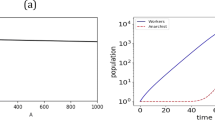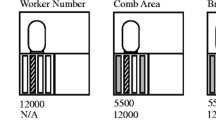Summary
An equilibrium model is developed which seeks to explain the regulation of queen rearing in honeybee colonies preparing to swarm. The model postulates that there is a balance between nurse bees becoming inhibited from queen rearing and nurses losing their inhibition, and that whether a colony does or does not rear queens reflects the equilibrium percentage of inhibited nurses. This model leads to a quantitative prediction about the size of a conoly's nurse population at which queen rearing should start. Comparing the model's predictions with empirical observations pinpoints data needed for a more complete explanation of control of queen rearing. In particular, the model suggests a central regulatory role for density-dependent changes in the behaviors involved in queen substance dispersal.
Similar content being viewed by others
References
Adams J, Rothman ED, Kerr WE, Paulino ZL (1977) Estimation of the number of sex alleles and queen matings from diploid male frequencies in a population of Apis mellifera. Genetics 86:583–596
Butler CG (1954) The method and importance of the recognition by a colony of honeybees (A. mellifera) of the presence of its queen. Trans R Entomol Soc London 105:11–29
Butler CG (1974) The world of the honey-bee. Collins, London
Ferguson AW, Free JB (1980) Queen pheromone transfer within honeybee colonies. Physiol Entomol 5:359–366
Free JB (1977) The social organization of honeybees. Edward Arnold, London
Getz WM, Bruckner D, Parisian T (1982) Kin structure and the swarming behavior of the honey bee Apis mellifera. Behav Ecol Sociobiol 10:265–270
Groot AP de, Voogd S (1954) On the ovary development in queenless worker bees (Apis mellifica L.). Experientia 10:384–385
Juška A (1978) Temporal decline in the attractiveness of honeybee queen tracks. Nature 276:261
Juška A, Seeley TD, Velthuis HHW (1981) How honeybee queen attendants become ordinary workers. J Insect Physiol 27:515–519
Lensky Y, Slabezki Y (1981) The inhibiting effect of the queen bee (Apis mellifera L.) foot-print pheromone on the construction of swarming queen cups. J Insect Physiol 27:313–323
Lindauer M (1955) Schwarmbienen auf Wohnungssuche. Z Vergl Physiol 37:263–324
Lindauer M (1961) Communication among social bees. Harvard University Press, Cambridge
Michener CD (1974) The social behavior of the bees. Harvard University Press, Cambridge
Page RE, Metcalf RA (1982) Multiple mating, sperm utilization, and social evolution. Am Nat 119:263–281
Sakagami SF, Fukuda H (1968) Life tables for worker honeybees. Res Popul Ecol 10:127–139
Seeley TD (1979) Queen substance dispersal by messenger workers in honeybee colonies. Behav Ecol Sociobiol 5:391–415
Seeley TD, Fell RD (1981) Queen substance production in honey bee (Apis mellifera) colonies preparing to swarm (Hymenoptera: Apidae). J Kansas Ent Soc 54:192–196
Simpson J (1957) The incidence of swarming among colonies of honey-bees in England. J Agric Sci 49:387–393
Simpson J (1958) The factors which cause colonies of Apis mellifera to swarm. Insectes Soc 5:77–95
Simpson J (1959) Variation in the incidence of swarming among colonies of Apis mellifera throughout the summer. Insectes Soc 6:85–99
Simpson J (1966) Congestion of adult honeybees with and without adequate hive space. J Apic Res 5:59–61
Simpson J (1968) L'essaimage. In: Chauvin R (ed) Traité de biologie de l'abeille, vol II. Masson, Paris, pp 32–44
Simpson J (1973) Influence of hive-space restricton on the tendency of honeybee colonies to rear queens. J Apic Res 12:183–186
Simpson J, Riedel IBM (1963) The factor that causes swarming by honeybee colonies in small hives. J Apic Res 2:50–54
Taber S (1954) The frequency of multiple mating of queen honey bees. J Econ Entomol 47:995–998
Taber S (1955) Sperm distribution in the spermathecae of multiple-mated queen honey bees. J Econ Entomol 48:522–525
Verheijen-Voogd C (1959) How worker bees perceive the presence of their queen. Z Vergl Physiol 41:527–582
Vierling G, Renner M (1977) Die Bedeutung des Sekretes der Tergittaschendrüsen für die Attraktivität der Bienenkönigin genenüber jungen Arbeiterinnen. Behav Ecol Sociobiol 2:185–200
Voogd S (1955) Inhibition of ovary development in worker bees by extraction fluid of the queen. Experientia 11:181–182
Wilson EO (1971) The insect societies. Harvard University Press, Cambridge
Winston ML, Taylor OR (1980) Factors preceding queen rearing in the Africanized honeybee (Apis mellifera) in South America. Insectes Soc 27:289–304
Winston ML, Taylor OR, Otis GW (1980) Swarming, colony growth patterns, and bee management. Am Bee J 120:826–830
Author information
Authors and Affiliations
Rights and permissions
About this article
Cite this article
Baird, D.H., Seeley, T.D. An equilibrium theory of queen production in honeybee colonies preparing to swarm. Behav Ecol Sociobiol 13, 221–228 (1983). https://doi.org/10.1007/BF00299926
Received:
Accepted:
Issue Date:
DOI: https://doi.org/10.1007/BF00299926




